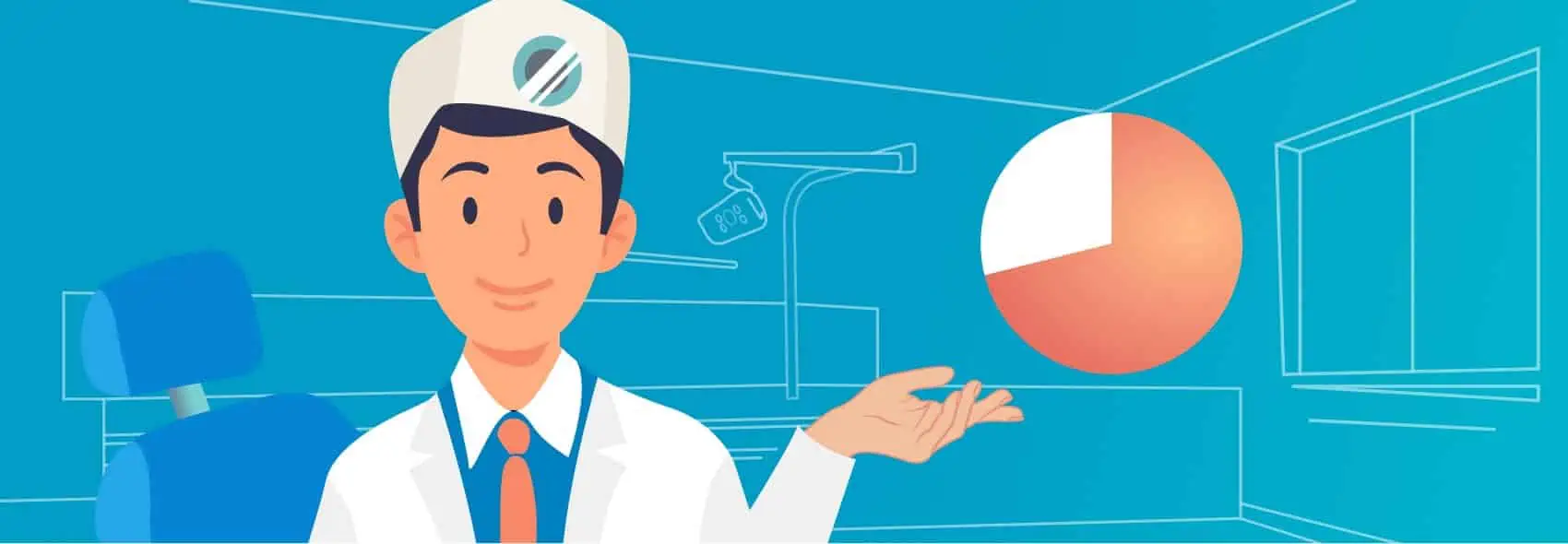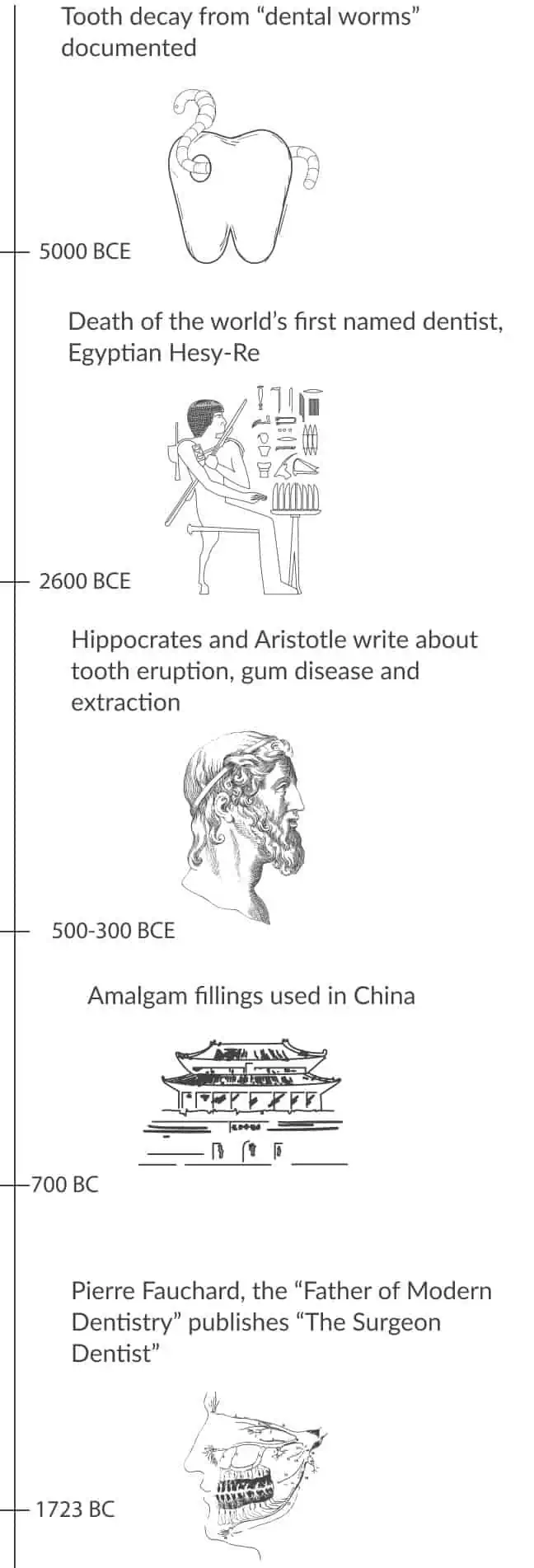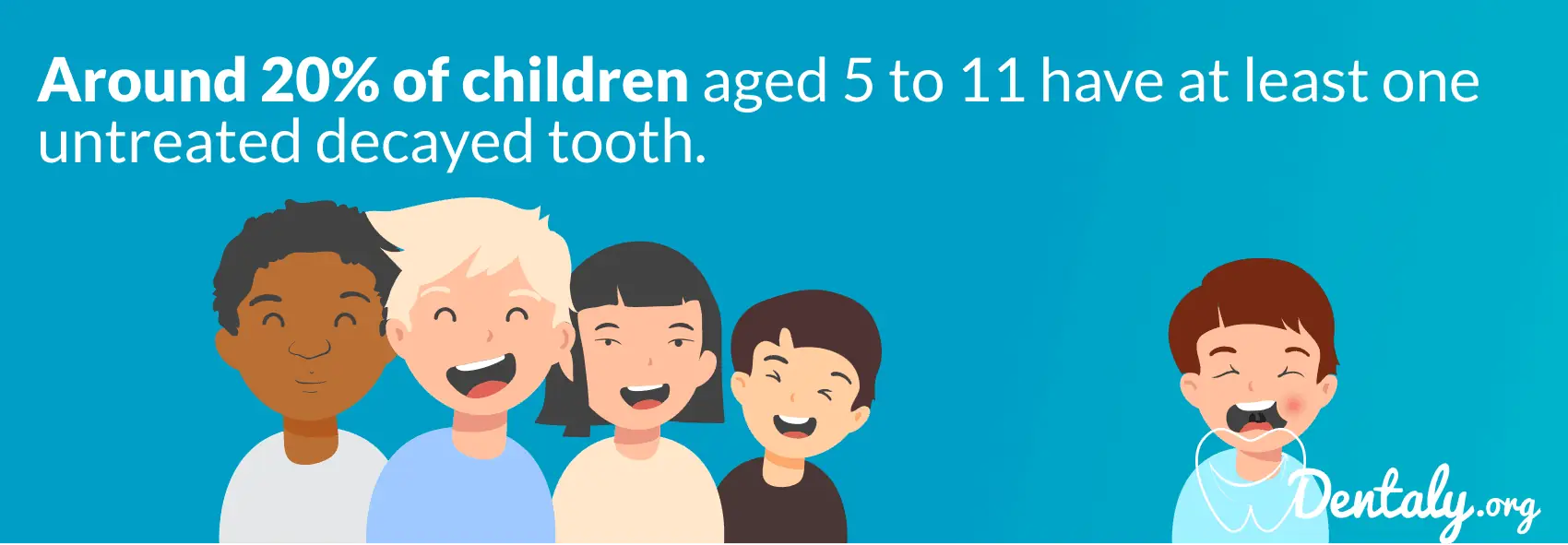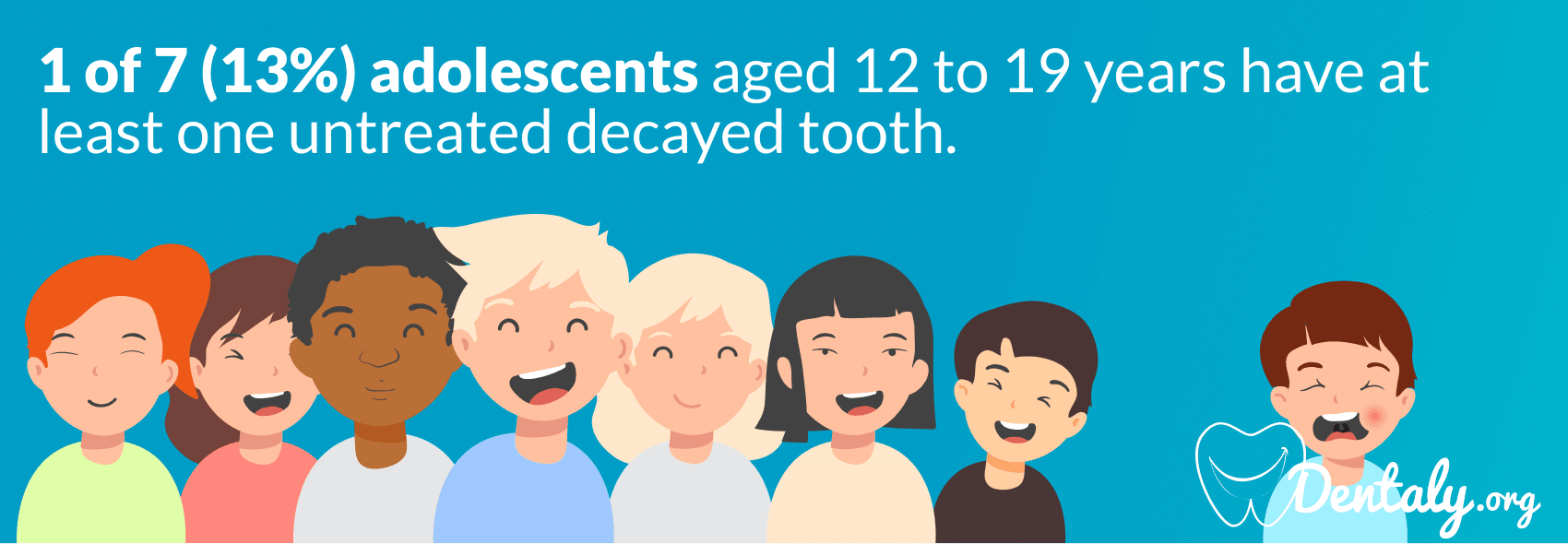

You never know when some interesting or fun dental facts will come in handy. Maybe you’re trying to figure out how to pay for your dental work. Or perhaps you’re looking to make learning more fun for your child with some dental trivia questions and fun dental facts for kids.
Or maybe you’re simply interested (and who could blame you) in the fascinating world of teeth.
Whatever your reason, it can be difficult to find all of the teeth facts you’re looking for, from trustworthy sources, easy to read, and in the same place. That’s why we’ve scoured the internet, from the CDC to the ADA to healthcare.gov, and back again to compile a list of helpful, interesting, fun, and weird facts about teeth. Whatever teeth fact you seek, we hope you find what you’re looking for.
Want dental statistics and facts about teeth for the UK instead? You can check them out here.
Dental history facts
Our first teeth fact takes us back to the past. Our cavemen ancestors were dealing with many of the same oral health issues that we deal with today, even if they didn’t know how to articulate those problems as well as we do. And recorded dental history goes as far back as 5000 BCE!
So let’s take a stroll back through time and learn all about dental care through the history of dentistry and teeth in general, and pick up some dental fun facts along the way. You’ll see that what is interesting about being a dentist, is that this profession is sort of rooted in philosophy.
- In 5000 BCE one of the first dentists made a note attributing dental decay to ‘tooth worms’ in a Sumerian text.
- 2600 BCE marks the death of the world’s first (known) dentist. He was named Hesy-Re, an Egyptian native whose tomb reads: “The greatest of those who deal with teeth, and of physicians.”
- From 500–300 BCE Hippocrates and Aristotle dabbled in dentistry, writing about the eruption pattern of teeth, gum disease, tooth extraction and even how to stabilize loose teeth with wires.
Ew! Thank goodness that decay isn’t referred to as ‘tooth worms’ anymore. And who knew that the first dentist was an Egyptian? Who knew that dentist facts could be so interesting? Let’s get back in the time machine and jump forward now to the Middle Ages!
- In 700 the Chinese were using amalgam fillings.
- The year 1210 sees the establishment of the Guild of Barbers in France. These surgeons specialized in bleeding, tooth extraction and of course, haircuts.
So, maybe you don’t like the idea of your barber pulling your teeth as well, but at least you had a one-stop-shop for your medical and cosmetic needs, talk about saving on gas money…or in this case hay. Let’s skip ahead to the 18th century when dentistry as a profession was born and see what interesting teeth fact we can dig up:
- In 1723, Pierre Fauchard, the “Father of Modern Dentistry” published “The Surgeon Dentist”, a book that lays out a system for the practice of dentistry including oral anatomy and restorative techniques.
- From 1750–1770 we have the career of the first dentist, Isaac Greenwood, to be born on American soil. Well, technically British-American soil, but not for long!
A brief history of dentistry
Have a look at the timeline below for a very brief history of dentistry fun facts and what dentistry looked like from its beginnings to the 18th century.




US dental statistics
Now let’s look at some US-specific dental statistics and dentistry fun facts…well maybe not so fun, especially the gum disease and tooth decay facts. You’ll see that if you suffer from gum disease or cavities, you’re definitely not alone. And if you were feeling bad about missing your last dental visit, (or your last 5 visits) you’re in good company, but you should make an appointment as soon as you can to see a dentist for a checkup and a deep cleaning.
- 15–20% of adults from 33 to 44 years of age have some form of gum disease.
- In adults between the ages of 20 and 64, 91% have dental caries and 27% have untreated tooth decay.
- 16% of people in the US suffer from tooth erosion, the third worst in the world.
- 12% of Americans say they grind their teeth.
- Only 7% of Americans say they are happy with their teeth.
- 34% of Americans suffer from tooth sensitivity
- Untreated tooth decay is higher for Hispanic and non-Hispanic black adults compared with non-Hispanic white and non-Hispanic Asian adults, which says a lot about racial inequality in the field of dentistry.
- There are only around seven dentists per 10,000 patients in the US.
- 84% of adults in the US between the ages of 18 and 34 say that bad teeth can negatively impact your life.
- 83% of adults in the US say that their current health-related priority is oral health. This is higher than mental health, exercise, and diet.
- Fewer than 1/3 of adults 65 and older have dental insurance.
- 38% of Americans prefer natural and organic toothpaste.
- 16% of Americans report having bad breath.
- 16.07 million people used a denture cleaner at least 8 times per week in 2019.
Interesting dentistry facts about children’s teeth in the US
Although there seems to have been a slight decrease in the number of cavities that children in the US have had over the years, experts say that this decline is not statistically significant. Let’s have a look at the current state of children’s teeth:
- Cavities are one of the most common chronic diseases in kids in the US.
- Children with poor oral health often miss more school and have lower grades than children with good oral health.




- Children between 5 and 19 years from low-income families are twice as likely to have cavities compared with children from higher-income households.
- Fluoride varnish can prevent 33% of cavities in baby teeth.
- Children who live in communities with fluoridated tap water have fewer cavities than children who don’t.
Dental hygiene facts
What do you know about dental hygiene? And what do your peers know? Chances are you feel a bit sheepish about your dental hygiene routine, but once you see these statistics and dental hygiene facts, you’ll see that most Americans could use a hygiene refresher as well.
Some of the more upsetting oral hygiene facts include that only 13.5% of us floss every day and 80% of us have some form of gum disease. But, just because most of us have bad dental hygiene habits, doesn’t make it OK. It’s time to step our game up!
- Around 78% of Americans have had at least one cavity by age 17.
- 80% of the population of the US has some form of gum disease.
- Three out of four people seen by dental hygienists don’t change their toothbrush as often as they should (every three months).
- You should change your toothbrush after you get sick!
- 39% of Americans brush their tongue regularly.
- Only 13.5% of Americans floss every day.
- 26% of Americans say they will skip brushing if they are in a rush in the morning.
- The main reason why people don’t floss is that they say it’s time-consuming (if that’s you – try a water flosser).
- 20% of adults only floss when they have something stuck in their teeth.
- Between 15% and 50% of people suffer from bad breath around the world.
Dental hygienist facts
Dental hygienists are highly trained professionals that help us keep our teeth clean. If you want to make the world a better place, it’s not a bad profession to go into:
- There are over 150,000 registered dental hygienists in the US.
- 98% of hygienists in the US are women.
- There are 300 entry-level degree programs, 60-degree completion programs, and 18 master’s degree dental hygiene programs.
- There are over 150,000 registered dental hygienists in the US.
- The job market for dental hygienists is very healthy and only expecting to get better!
Dental phobia statistics
None of us actually look forward to going to the dentist, we at best feel neutral about it, but some people experience so much fear of the dentist that they put off getting the care they need. But by not going to the dentist, they only exacerbate their dental health problems and will need even more significant treatment when they finally do go to the dentist.
And, well, the thought of drastic treatment makes them even more afraid to go. If you can relate to this vicious cycle, you are not alone. Have a look at these stats, and you’ll see that a lot of people in the United States suffer from the same condition.
- 50 to 80% of adults in the United States have some dental anxiety. Some visit a dentist less often than they should, while others avoid dental trips completely because of their phobia.
- Dental anxiety is higher when pain has been experienced at previous dental visits.
- In most cases, the earlier you get your kids seeing the dentist regularly, the less dental anxiety they will have.
Wisdom teeth statistics
Despite their association with knowledge, we really don’t know a lot of wisdom teeth facts and tooth facts about wisdom teeth removal. But here’s a look at just a few:
- Wisdom teeth serve no purpose anymore. They were used for chomping into raw meat and roots. But now we eat softer foods, and we cook a lot of what we eat.
- The oldest known case of impacted wisdom teeth is from a woman who died 15,000 years ago.
- Some dentists always recommend the removal of wisdom teeth before there are any problems, while others say removal shouldn’t happen unless there’s impaction or infection.
Teeth whitening statistics
Chances are you’ve done it or are at least thinking about it. Teeth whitening is one of the most popular dental procedures. So let’s find out more about it:
- By 2024, it is projected that 38.92 million Americans will have used tooth whiteners.
- 80% of Americans between 18 and 49 want whiter teeth.
- 85% of those are women.
- Americans spent more than $1.4 billion on over-the-counter tooth whitening products last year alone.
- 15% of Americans reported using household bleach to whiten their teeth!
Missing teeth statistics
Missing teeth aren’t just an aesthetic problem, they also make it more difficult to eat and chew food. And over time, they result in bone loss from your jaw. If you’re missing a tooth or two, you’re in good company.
Almost 1/3 of adults between the ages of 65 and 74 have no natural teeth. And if you aren’t one of the 178 million Americans missing at least one tooth, chances are that if you want to keep it that way, you need to start taking better care of your mouth!
- 30% of adults between the ages of 65 and 74 years have no natural teeth.
- The most common reasons for losing a tooth are dental decay, gum and bone disease or trauma.
Find out more in our post ‘What Percent of the Population is Missing Teeth?‘
Dental implant facts
If you are one of the many millions of Americans with missing teeth, then you probably know that missing even just one tooth can make it difficult to eat or speak properly. Another thing that happens is that your surrounding teeth become at greater risk of damage and your jaw may suffer bone loss.
Dental implants are one of the best ways, if not the best way, to replace missing teeth. The only problem is that they are too expensive for most people.
Let’s have a look at some statistics for this tooth replacement option:
- Dental implants are considered to be the best way to replace missing teeth.
- Dental implants have a success rate of 98%.
- 30% of US general practitioners expect to place implants.
- Immediate-load implants will comprise around 15% of all implant procedures.
- The first dental implants could go back as far as 600 AD. The remains of a Mayan woman from that time was found with tooth-like pieces of shell hammered into her jaw! Ouch!
- Titanium, which is used in dental implants, naturally fuses with bone, which is why these are a permanent solution.
- Just over 3 million people in the US have implants; not many considering they are the best way to replace teeth! Must be due to the high cost of dental implants, and the lack of federal funding for dental insurance!
- The number of implant patients in the US grows by 500,000 per year.
- Although mini dental implants are considered the best solution in cases when there isn’t sufficient bone or gum tissue for standard implants, their use is declining due to the increase in the perception that they don’t offer adequate restorative capabilities.
Paying for dental work
Now it’s time to move on from fun facts about teeth to some more sobering dental statistics. The largest problem keeping Americans from getting the dental care they need is the fact that paying for dental work can be difficult or even impossible for many families and individuals.
Despite the fact that any sort of medical care should be a right, whether or not you can pay for it, we’ve got a long way to go before everyone has free access to dental care. Let’s have a look at just how bad this problem is.
- 59% of adults say they don’t go to the dentist because of costs. Did you know that universal healthcare could help solve this problem?
- 38.5% of children have dental benefits through Medicaid or CHIP.
- 35 states including the District of Columbia provide at least limited dental benefits for adults on Medicaid. That’s why it’s so important to support these programs!
- 20.9% of patients are primarily concerned with the unexpectedly high costs of services and treatments, including the cost of braces and other elective procedures.
- Most state Medicaid (government sponsored insurance) programmes do not cover adult dental care.
Oral health facts and teeth facts for kids
Dental trivia for kids is a great way to get them more involved in their dental health. So have a look at these fun facts for kids and get them interested in their dental health with these dental health facts, dental fun facts and weird facts about teeth.
- Natural, healthy teeth aren’t actually pure white! They are a slightly yellow color. That’s because there’s a layer of yellow dentin under the outer layer of enamel.
- Some babies are born with teeth showing! And some children don’t get their first tooth until after age one.
- Before modern toothbrushes were invented, people used to chew on frayed twigs to clean their teeth.
- Scientists can tell how old you are by looking at your teeth.
- Just like fingerprints, no two tongues are alike!
- No two teeth in your mouth are the same.
- In 1950, the Tooth Fairy brought on average 25 cents. Now the Tooth Fairy brings around $2.00 per tooth! Fun fact about teeth? More like fund fact about teeth!
- A mouth produces an average of 10,000 gallons of spit during a lifetime. Now that is a funny dental fact! And kind of gross too!
- At most, you’ll probably have 32 adult teeth, and then 28 if you get your wisdom teeth out. The person with the most teeth in the world has 37 and lives in India.
- When kids get sealants on their teeth, it can prevent around 80% of cavities.
US vs UK
We all know about the stereotype that British people have bad teeth. But are ours really that much better? Well, the average American is actually missing more teeth than the average Brit, but only just.
This may be because the US has higher levels of economic inequality compared to the UK.
In the UK, you can get subsidized dental care from the NHS, whereas in the United States you’re lucky if you live in a state with state-funded healthcare that covers dental work. Although, there are many people working to get rid of this program as we speak, well, as you read.
So there you have it! All sorts of interesting oral health facts and dental facts, some informative, some a bit depressing, some optimistic and some just downright strange! Either way, you now know some important things in the field of dentistry that you can share with others.
Browse our other articles for more information all about dental care, or check out our dental dictionary to learn more about some of the technical terms your dentist throws around. You can also check out our article on the average dentist salary if you’re interested to find out how much you could make.


ADA.org: History of Dentistry. Consulted 22nd February 2024.
Prosthodontics.org: Missing Teeth. Consulted 22nd February 2024.
CDC.org: Dental Caries and Tooth Loss in Adults in the United States, 2011–2012. Consulted 22nd February 2024.
Foundation for Oral Rehabilitation: Facts about Dental Implants. Consulted 22nd February 2024.
BMJ.org: Austin Powers bites back: a cross sectional comparison of US and English national oral health surveys. Consulted 22nd February 2024.
American Academy of Implant Dentistry: What are dental implants? Consulted 22nd February 2024.
iData Research: US Dental Implant Statistics Show a Shift to Value & Discount Implants. Consulted 22nd February 2024.
Statista.com: Percentage of adults in the U.S. who stated bad teeth can have a negative impact on a person’s personal and professional life as of 2019, by age. Consulted 22nd February 2024.
GM: Halitosis: Identifying the cause. Consulted 22nd February 2024.
NCBI: “Early baby teeth”: Folklore and facts. Consulted 22nd February 2024.
NCBI: Tongue prints: A novel biometric and potential forensic tool. Consulted 22nd February 2024.
ADA.org: Patients. Consulted 22nd February 2024.
ADA.org: Dental Benefits and Medicaid. Consulted 22nd February 2024.
Sciencefocus.com: How much saliva do we produce in lifetime? Consulted 22nd February 2024.
heart.org: Warning Signs of a Heart Attack. Consulted 22nd February 2024.
Statista.com: Oral health and dental care in the U.S. – Statistics & Facts. Consulted 22nd February 2024.
Statista.com: Percentage of adults in the U.S. who stated the following were their current health-related priorities as of 2019. Consulted 22nd February 2024.
CDC.gov: Dental Care Among Adults Aged 65 and Over, 2017. Consulted 22nd February 2024.
CDC.gov: Children’s Oral Health. Consulted 22nd February 2024.
CDC.gov: Prevalence of Total and Untreated Dental Caries Among Youth: United States, 2015-2016. Consulted 22nd February 2024.
Guinnessworldrecords.com: Record Holder Profile Video: Vijay Kumar – the man with the most teeth. Consulted 22nd February 2024.
Princeton.edu: Anthropologist Mann builds body of evidence with evolution studies. Consulted 22nd February 2024.
Statista.com: U.S. population: Usage of tooth whiteners from 2011 to 2023. Consulted 22nd February 2024.
NCBI: Tooth Whitening: What We Now Know. Consulted 22nd February 2024.
NCBI: Effects of a Novel Whitening Formulation on Dental Enamel. Consulted 9th March 2024.
Statista.com: U.S. population: Number of uses of denture cleaners within 7 days from 2011 to 2019. Consulted 11th May 2024.
Statista.com: Share of consumers who prefer to purchase natural or organic oral care products as of May 2017. Consulted 11th May 2024.
Sunstar: Global Healthy Thinking Report. Consulted 17th February 2024.




